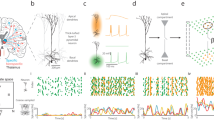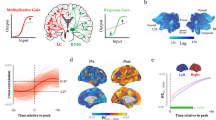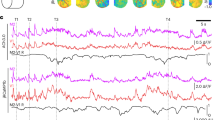Abstract
Arousal patently transforms the faculties of complex organisms. Although typical changes in cortical activity such as seen in EEG and LFP measurements are associated with change in state of arousal, it remains unclear what in the constitution of such state dependent activity enables this profound enhancement of ability. We put forward the hypothesis that arousal modulates cortical activity by rendering it more fit to represent information. We argue that representational capacity is of a dual nature—it requires not only that cortical tissue generate complex activity (i.e. spatiotemporal neuronal events), but also a complex cortical activity space (which is comprised of such spatiotemporal events). We explain that the topological notion of complexity—homology—is the pertinent measure of the complexity of neuronal activity spaces, as homological structure indicates not only the degree to which underlying activity is inherently clustered but also registers the effective dimensionality of the configurations formed by such clusters. Changes of this sort in the structure of cortical activity spaces can serve as the basis of the enhanced capacity to make perceptual/behavioral distinctions brought about by arousal. To show the feasibility of these ideas, we analyzed voltage sensitive dye imaging (VSDI) data acquired from primate visual cortex in disparate states of arousal. Our results lend some support to the theory: first as arousal increased so did the complexity of activity (that is the complexity of VSDI movies). Moreover, the complexity of structure of activity space (that is VSDI movie space) as measured by persistent homology—a multi scale topological measure of complexity—increased with arousal as well.








Similar content being viewed by others
Notes
In what follows we limit our discussion to the continuum of states ranging from loss of consciousness through dreamless sleep and drowsiness (or quiet wakefulness) to full fledged alertness (something like the peak in the Yerkes–Dodson Law 1908). Within this range states of arousal seem to lie on a continuum (i.e. a one manifold, see Hobson et al. 2000).
Throughout the discussion we assume that each point in a given activity space is equiprobable. Note however that the foregoing discussion is easily applicable to spaces in which points differ in their probability, for example due to inherent noise (that is at times the system is “inaccurate” while generating activity). Adequate samples from such a space will contain subspaces which differ in their density (regions containing points of low probability will give rise to low density regions in the sample and vice versa). In such cases samples can be first thresholded by density (de Silva and Carlsson 2004), and the computations described below carried out unchanged.
Our discussion concerns the scenario in which a system is to represent information by activity alone. However one might argue that neural systems are actually engaged in coding (in the information theoretic sense); that is in attaching arbitrary codes to objects/parameters/events. Thus given a suitable decoding mechanism what appears to be noise (i.e. a homogeneous distribution) is actually perfectly matched to the task. There is however strong evidence that this is not the case in neuronal systems. Sharma et al. (2000) report that when the optic nerve of a ferret is connected to the primary auditory cortex, orientation maps are developed in A1, as is sight (von Melchner et al. 2000). In other words the activity of brain stem structures contains sufficient information about the nature of stimuli for the cortex to adapt without some hardwired decoding mechanism resulting from natural selection.
Note that activity spaces seem not to be clustered per se—as sensory objects (such as images and sounds) can be smoothly warped into any other sensory object. This would indicate that activity spaces consist of single components. However as mentioned, higher order homological structure results in inhomogeneous samples, i.e. they possess of structure which can be learned and therefore acted upon.
Each movie was band-pass filtered in space and time. Spatial parameters were chosen according to the spatial frequency of the orientation domains in the imaged cortex. Temporal parameters were chosen according to the time course of the stimulus (a square wave, in which the upper phase represents the presence of a stimulus). This was done in order to suppress spontaneous activity components in the data, to enable the visualization of the ring structure.
The reason for segmenting data into second long movies is that EEG measurements indicate that arousal related phenomena occur (that is to say, can be detected) at this time scale. The exact duration (a second rather than 2, 3 or 5) was chosen as a compromise between the number of resulting points (which decreases as the duration of each movie is increased) and the ability to detect state dependent differences in the VSDI data.
The characteristic value was taken as the mean SIF value associated with instances of activity recorded while subjects were in a designated state of arousal.
Given a function F:M→N, the level set for \(c \in F\left( M \right)\) is all the set of all points \(x \in M\) for which F(x) = c. In our case M is movie space and N is \(\mathbb{R}\), the real line.
It is likely that typical distribution of energy in different spatiotemporal bands attests to the complexity of activity as well. The efficacy of readout of activity, that is, the activity of neurons that form synapses with the neurons whose activity is measured, critically depends on the spatiotemporal makeup of the data. Given the pattern of connectivity, and distribution of cell types in the readout network, some spatiotemporal regimes will be more effective than others, that is will be better suited to drive the network, and thus more effective in their ability to carry information. However without detailed anatomical and functional analysis, such claims cannot be substantiated, and thus we cannot claim that these features are actually legitimate measures of complexity as conceived by us throughout this discussion.
These features were more than necessary to achieve perfect classification. However all the computed features that significantly differentiated among any pair of conditions were retained in order to preserve all the state dependent information afforded by the data which we were able to detect.
Either a smooth step function (implementing a one sided inequality), or a smooth bump function (implementing a two sided inequality).
An illustrative example is the analysis of an image at different resolutions. Consider a HD picture of a face, in which case one can zoom in and track pours in the skin (“holes” in our metaphor). However, if the image is downsampled such features are no longer discernable (or they do not persist at this scale). Further downsampling will cause other features to disappear—such as nostrils. Finally, additional downsampling will result in a blob (a smooth gradient of color).
The difference in shape between the first and second Betti curves and the third curve results (in part) from landmarking. Without suitable landmarking rather than remaining constant the zero Betti graph would have decayed from n, the number of points, to 1, and as a result the first and second graphs would resemble the third one in shape. The reason is that the probability of finding pairs of points whose distance is below a given threshold is larger than the probability of finding triplets for smaller scales (up until saturation that is). The same is true if quartets and triplets are compared and see (Robins 2000, 2002, 2006).
From the vantage point of homology a shirt punctured by a needle and by a spear would be one and the same.
Or at least its most salient features.
There are, of course, other factors which work alongside this in forming the geometry of neuronal activity spaces. For example, it seems likely that representation is biased to represent aspects of the environment which are particularly important for certain species. Also neuronal systems might implement biases to achieve computational goals in general (such in the case of constancy mechanisms), sacrificing the correspondence to input in the strictest sense.
That is changes in density in the distribution of activity above the systems threshold of detection.
The simplest example would be warping a line until its ends meet—i.e. a ring is formed. Similarly stretching a surface can result in a tear—i.e. the emergence of a hole.
i.e. the empirical data is used as the seed for the first sweep, while the next iterations commence from the points resulting from the previous iteration (which are 0.01 SD from the characteristic value), and so on.
References
Arieli, A., & Grinvald, A. (2002). Optical imaging combined with targeted electrical recordings, microstimulation, or tracer injections. Journal of Neuroscience Methods, 116(1), 15–28.
Arieli, A., Shoham, D., Hildesheim, R., & Grinvald, A. (1995). Coherent spatiotemporal patterns of ongoing activity revealed by real-time optical imaging coupled with single-unit recording in the cat visual cortex. Journal of Neurophysiology, 73, 2072–2093.
Arieli, A., Sterkin, A., Grinvald, A., & Aertsen, A. (1996). Dynamics of ongoing activity: Explanation of the large variability in evoked cortical responses. Science, 273, 1868–1871. doi:10.1126/science.273.5283.1868.
Cao, Y., Cai, Z., Shen, E., Shen, W., Chen, X., Gu, F., et al. (2007). Quantitative analysis of brain optical images with 2D C 0 complexity measure. J Neurosci Methods, 15, 159(1), 181–186.
Carlsson, G., & de Silva, V. (2004). Topological estimation using witness complexes. Symposium on Point-Based Graphics.
Carlsson, G., Ishkhanov, T., de Silva, V., & Zomorodian, A. (2008). On the local behavior of spaces of natural images. International Journal of Computer Vision, 76(1), 1–12. doi:10.1007/s11263-007-0056-x.
Contreras, D., & Llinas, R. (2001). Voltage-sensitive dye imaging of neocortical spatiotemporal dynamics to afferent activation frequency. The Journal of Neuroscience, 21(23), 9403–9413.
de Silva, V. (2003). A weak definition of Delaunay triangulation. CoRR, cs.CG/0310031.
de Silva, V., & Carlsson, G. (2004). Topological estimation using witness complexes. Symposium on Point-Based Graphics, ETH, Zürich, Switzerland.
Edelman, S. (1998). Representation is representation of similarities. The Behavioral and Brain Sciences, 21, 449–498.
Edelman, S. (1999). Representation and recognition in vision. Cambridge, MA: Bradford Books.
Edelman, S. (2001). Neural spaces: A general framework for the understanding of cognition? The Behavioral and Brain Sciences, 24, 664–665. doi:10.1017/S0140525X01320083.
Edelsbrunner, H., Letscher, D., & Zomorodian, A. (2002). Topological persistence and simplification. Discrete & Computational Geometry, 28(4), 511–533. doi:10.1007/s00454-002-2885-2.
Fiser, J., Chiu, C., & Weliky, M. (2004). Small modulation of ongoing cortical dynamics by sensory input during natural vision. Nature, 431(7008), 573–578. doi:10.1038/nature02907.
Gardenfors, P. (2000). Conceptual spaces. Cambridge, MA: Bradford Books.
Gervasoni, D., Lin, S. C., Ribeiro, S., Soares, E. S., Pantoja, J., & Nicolelis, M. A. (2004). Global forebrain dynamics predict rat behavioral states and their transitions. The Journal of Neuroscience, 24(49), 11137–11147. doi:10.1523/JNEUROSCI.3524-04.2004.
Grinvald, A., & Hildesheim, R. (2004). VSDI: A new era in functional imaging of cortical dynamics. Nature Reviews Neuroscience, 5(11), 874–885. doi:10.1038/nrn1536.
Grinvald, A., Shoham, D., Shmuel, A., Glaser, D., Vanzetta, I., Shtoyermann, E., et al. (2001). In-vivo optical imaging of cortical architecture and dynamics. In Modern techniques in neuroscience research. Berlin: Springer.
Hobson, A. J., Pace-Schott, E., & Stickgold, R. (2000). Dreaming and the brain: Toward a cognitive neuroscience of conscious states. The Behavioral and Brain Sciences, 23(6), 793–842, 904–1018, 1083–1121. doi:10.1017/S0140525X00003976.
Kendall, D. G., Barden, D., Carne, T. K., & Le, H. (1999). Shape and shape theory. New York: Wiley.
Kenet, T., Bibitchkov, D., Tsodyks, M., Grinvald, A., & Arieli, A. (2003). Spontaneously emerging cortical representations of visual attributes. Nature, 425(6961), 954–956. doi:10.1038/nature02078.
Lee, J. (2003). Introduction to smooth manifolds. Graduate texts in Mathematics 218. Berlin: Springer.
Leznik, E., Makarenko, V., & Llinas, R. (2002). Electrotonically mediated oscillatory patterns in neuronal ensembles: An in vitro voltage-dependent dye-imaging study in the inferior olive. The Journal of Neuroscience, 22(7), 2804–2815.
Llinas, R., Lang, E. J., Welsh, J. P., & Makarenko, V. I. (1997). A new approach to the analysis of multidimensional neuronal activity: Markov random fields. Neural Networks, 10(5), 785–789. doi:10.1016/S0893-6080(97)00025-7.
Longnecker, D. E., Brown, D. L., Newman, M. F., & Zapol, W. M. (2007). Anesthesiology pp. 863–864. New York: McGraw-Hill.
Munkres, J. R. (1984). Elements of algebraic topology. New York: Perseus Books.
Omer, D. B., Blumenfeld, B., Tsodyks, M., & Grinvald, A. (2009). A novel method to analyze optical imaging data. Neuron Technique (in press).
Petersen, C. C., Grinvald, A., & Sakmann, B. (2003a). Spatiotemporal dynamics of sensory responses in layer 2/3 of rat barrel cortex measured in vivo by voltage-sensitive dye imaging combined with whole-cell voltage recordings and neuron reconstructions. The Journal of Neuroscience, 23(4), 1298–1309.
Petersen, C. C., Hahn, T. T., Mehta, M., Grinvald, A., & Sakmann, B. (2003b). Interaction of sensory responses with spontaneous depolarization in layer 2/3 barrel cortex. Proceedings of the National Academy of Sciences of the United States of America, 100(23), 13638–13643. doi:10.1073/pnas.2235811100.
Robins, V. (2000). Computational topology at multiple resolutions. PhD thesis, Department of Applied Mathematics, University of Colorado, Boulder.
Robins, V. (2002). Computational topology for point data: Betti numbers of alpha-shapes in morphology of condensed matter: Physics and geometry of spatially complex systems. In Mecke, K., & Stoyan, D. (Eds), Lecture notes in physics, vol. 600, (pp. 261–275). Berlin: Springer.
Robins, V. (2006). Betti number signatures of homogeneous Poisson point processes. Physical Review E, 74, 061107.
Sharma, J., Angelucci, A., & Sur, M. (2000). Induction of visual orientation modules in auditory cortex. Nature, 404(6780), 841–847.
Sharon, D., & Grinvald, A. (2002). Dynamics and constancy in cortical spatiotemporal patterns of orientation processing. Science, 295(5554), 512–515. doi:10.1126/science.1065916.
Shepard, R. N. (1987). Toward a universal law of generalization for psychological science. Science, 237(4820), 1317–1323. doi:10.1126/science.3629243.
Shoham, D., Glaser, D. E., Arieli, A., Kenet, T., Wijnbergen, C., Toledo, Y., Hildesheim, R., & Grinvald, A. (1999). Imaging cortical dynamics at high spatial and temporal resolution with novel blue voltage-sensitive dyes. Neuron, 24, 791–802. doi:10.1016/S0896-6273(00)81027-2.
Slovin, H., Arieli, A., Hildesheim, R., & Grinvald, A. (2002). Long-term voltage-sensitive dye imaging reveals cortical dynamics in behaving monkeys. Journal of Neurophysiology, 88(6), 3421–3438. doi:10.1152/jn.00194.2002.
Small, C. G. (1996). The statistical theory of shape. In Springer Series in Statistics. New York: Springer.
Sporns, O., Tononi, G., & Edelman, G. M. (2000). Connectivity and complexity: The relationship between neuroanatomy and brain dynamics. Neural Networks, 13(8–9), 909–922. doi:10.1016/S0893-6080(00)00053-8.
Tononi, G. (2004). An information integration theory of consciousness. BMC Neuroscience, 5(1), 42. doi:10.1186/1471-2202-5-42.
Tononi, G., & Edelman, G. M. (1998). Consciousness and complexity. Science, 282(5395), 1846–1851. doi:10.1126/science.282.5395.1846.
Tsodyks, M., Kenet, T., Grinvald, A., & Arieli, A. (1999). Linking spontaneous activity of single cortical neurons and the underlying functional architecture. Science, 286, 1943–1946. doi:10.1126/science.286.5446.1943.
von Melchner, L., Pallas, S. L., & Sur, M. (2000). Visual behavior mediated by retinal projections directed to the auditory pathway. Nature, 404(6780), 871–876. doi:10.1038/35009102.
Yaffe, E., Fishelovitch, D., Wolfson, H. J., Nussinov, R., & Halperin, D. (2008). MolAxis: Efficient and accurate identification of channels in macromolecules. PROTEINS: Structure, Function, and Bioinformatics, 73, 72–86.
Yerkes, R. M., & Dodson, J. D. (1908). The relation of strength of stimulus to rapidity of habit-formation. Journal of Comparative Neurology and Psychology, 18, 459–482. doi:10.1002/cne.920180503.
Zomorodian, A., & Carlsson, G. (2005). Computing persistent homology. Discrete & Computational Geometry, 33(2), 249–274. doi:10.1007/s00454-004-1146-y.
Acknowledgements
We thank Rina Hildesheim for the dyes and Yuval Toledo for computer technical assistance. We thank David Blanc for the invaluable discussions of the ideas presented here. Also, we thank Shimon Edelman for his meticulous reading of the manuscript and helpful remarks. We thank Vanessa Robins and Boaz Nadler for helpful advice. Finally we thank Neta Zach for just about everything. This work was supported by The Weizmann Institute of Science, Rehovot, Israel, and an EU Daisy grant.
Author information
Authors and Affiliations
Corresponding author
Additional information
Action Editor: Alessandro Treves
Electronic supplementary material
Below is the link to the electronic supplementary material.
Supplementary material
Homology-primer (DOC 362 KB).
Supplementary box 1
The level set approximation routine (DOC 36.5 KB).
Supplementary Fig. 1
(GIF 17.4 KB).
Supplementary Fig. 2
(GIF 7.01 KB).
Supplementary Fig. 3a
(GIF 102 KB).
Supplementary Fig. 3b
(GIF 80.5 KB).
Supplementary Fig. 4
(GIF 65.7 KB).
Rights and permissions
About this article
Cite this article
Fekete, T., Pitowsky, I., Grinvald, A. et al. Arousal increases the representational capacity of cortical tissue. J Comput Neurosci 27, 211–227 (2009). https://doi.org/10.1007/s10827-009-0138-6
Received:
Revised:
Accepted:
Published:
Issue Date:
DOI: https://doi.org/10.1007/s10827-009-0138-6




